PCP Screening for MASH/MASLD: Identifying At-Risk Patients
Chat with MASLD AI

Hi, I am MASLD AI.
Suggested Questions :

MASLD AI 08:32 PM

In this essential FAQ video, Jennifer Geremia, PA-C, a seasoned gastroenterology provider practicing in Boston, outlines current primary care screening guidelines for identifying patients at risk for metabolic dysfunction-associated steatohepatitis (MASH) and MASLD. With nearly two decades of experience caring for GI and liver patients, Jennifer emphasizes the importance of integrating liver health into routine health maintenance—particularly for individuals with type 2 diabetes, obesity, metabolic syndrome, and related conditions. She reviews practical steps for risk stratification, beginning with FIB-4 scoring using readily available labs, and discusses how to interpret and act on the results, including when to refer for further testing like elastography or ELF testing. Viewers will also gain insight into patient counseling strategies, alcohol intake guidance, and the urgency of acting early—even in asymptomatic patients. This video is a must-watch for primary care clinicians aiming to improve detection and management of MASH and MASLD through evidence-based screening and timely intervention.
Related Podcast
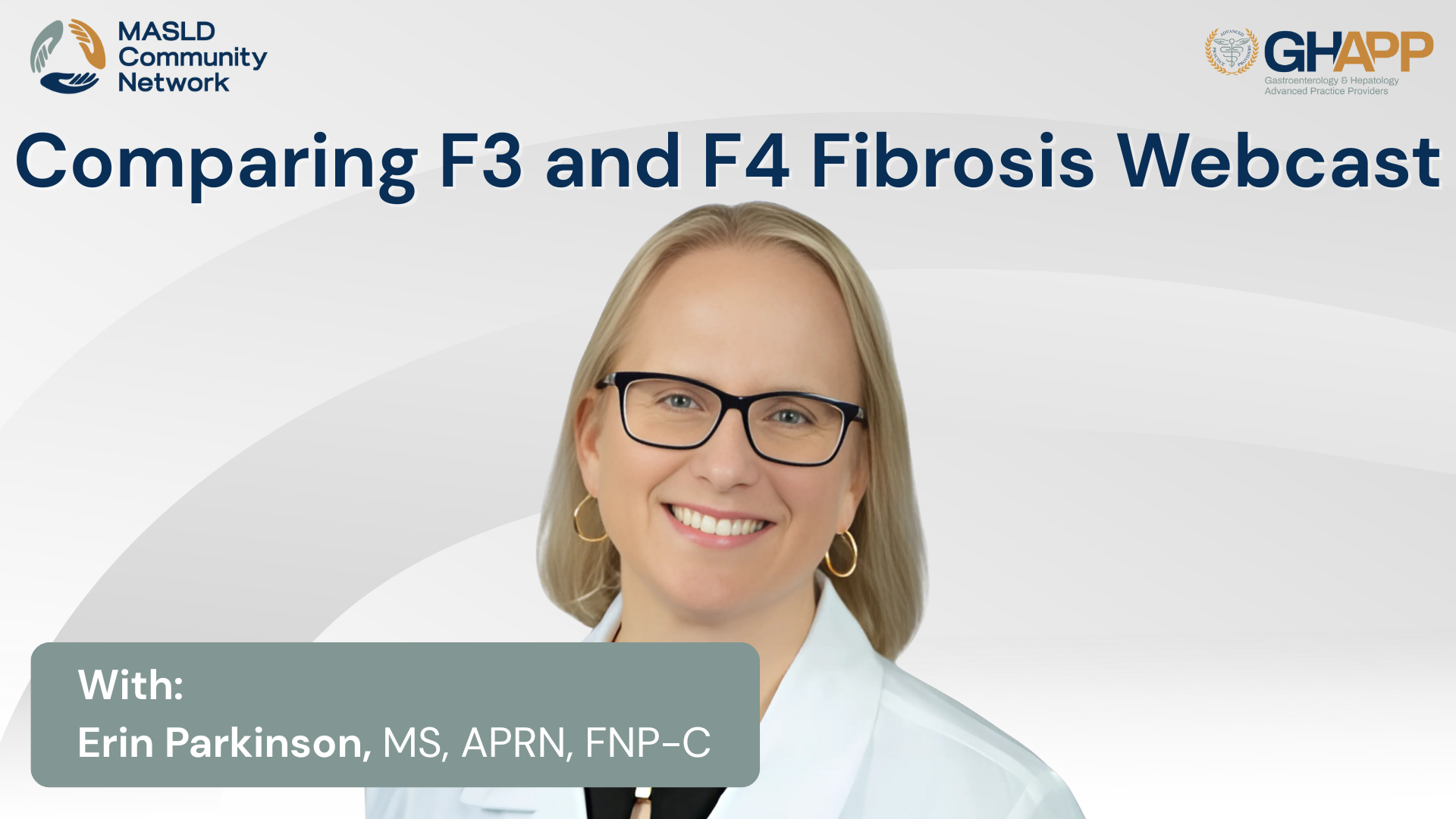
Comparing F3 and F4 Fibrosis With Erin Parkinson

In this in-depth clinical discussion, Erin Parkinson, NP from the Tampa General Medical Group Transplant Institute, walks through the nuanced process of differentiating stage 3 and stage 4 fibrosis in patients with MASLD (Metabolic Dysfunction-Associated Steatotic Liver Disease). Using two illustrative case studies, she explores key clinical signs, lab values, and non-invasive staging tools such as FibroScan, FIB-4, ELF score, and MR elastography. Parkinson discusses the importance of early identification of advanced fibrosis, the reversibility of stage 3 disease, and the implications of a diagnosis of cirrhosis. Erin outlines evidence-based treatment pathways including lifestyle interventions, use of GLP-1 receptor agonists, and initiation of resmetirom (Rezdiffra) for stage 2–3 fibrosis. For cirrhotic patients, the focus shifts to HCC surveillance, screening for clinically significant portal hypertension, and consideration of non-selective beta blockers like carvedilol. This video offers practical insights for hepatology providers navigating the evolving MASLD landscape and highlights how early intervention and accurate staging can impact long-term outcomes.
Watch Now
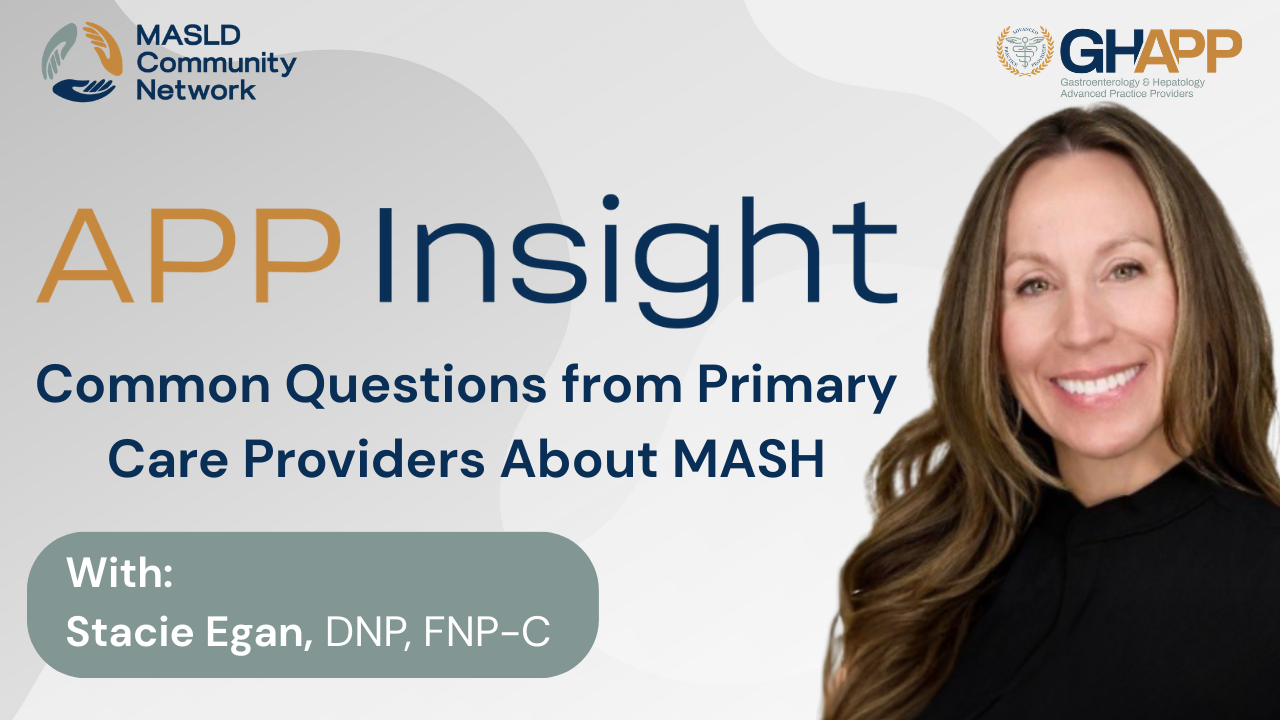
Common Questions From Primary Care Providers About MASH With Stacie Egan

In this educational session, Stacie Egan, DNP at Ogden Clinic GI in Ogden, Utah, shares practical insights on managing patients with MASH and fibrosis in clinical practice. Drawing from her experience treating patients with F2–F3 fibrosis, Stacy highlights the effectiveness of emerging pharmacotherapies and the positive outcomes she has seen in her patients. She emphasizes the critical role of primary care providers as gatekeepers in identifying at-risk patients, particularly those with metabolic syndrome, type 2 diabetes, obesity, hypertension, or hyperlipidemia. By utilizing simple tools like the FIB-4 score, primary care teams can begin the process of risk stratification and ensure that patients receive timely referrals for additional testing such as FibroScan, MRE, or liver biopsy. Stacie also discusses the importance of distinguishing between low, indeterminate, and high-risk patients, ensuring that those with advanced fibrosis (F2, F3, and F4) receive appropriate treatment, monitoring, and, when needed, referral to hepatology for transplant evaluation. This video serves as an important resource for providers across specialties, reinforcing the need for collaboration to detect and treat MASH with fibrosis early, improve patient outcomes, and help reverse steatosis and fibrosis.
Watch Now
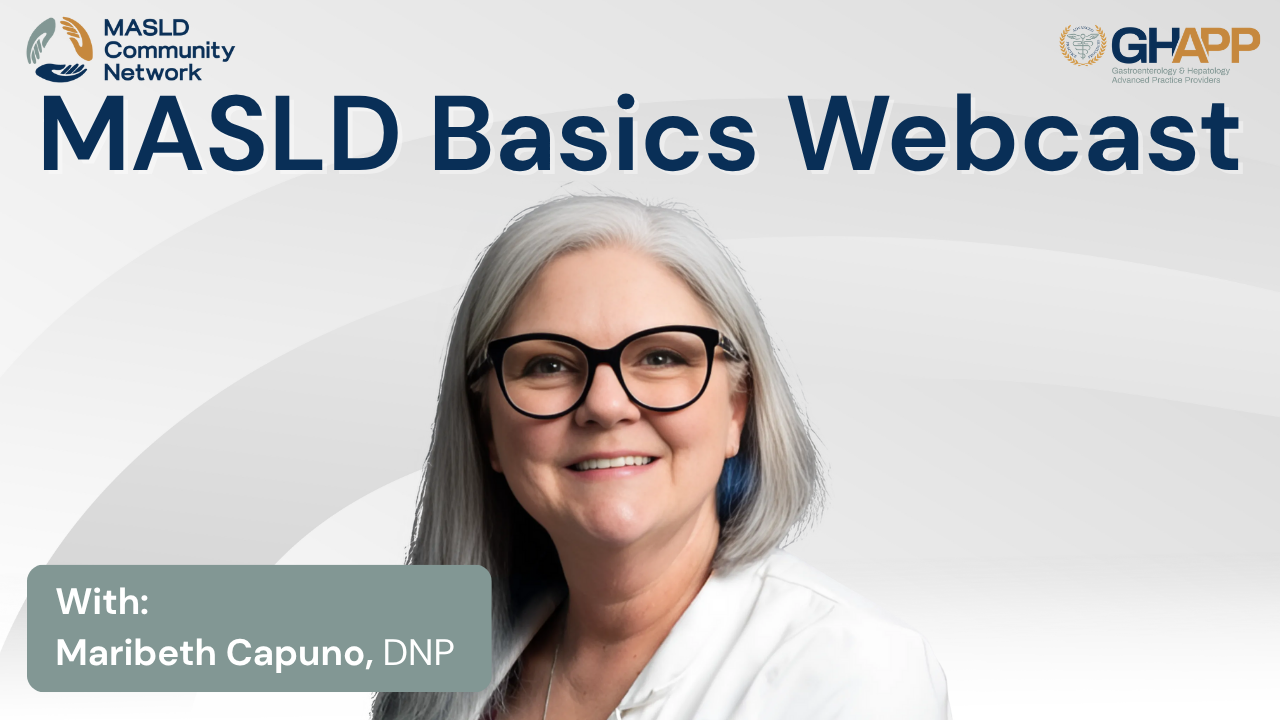
MASLD Basics With Maribeth Capuno

Join us for an in-depth overview of steatotic liver disease, presented through the GHAPP MASLD/MASH Community Network and proudly sponsored by Madrigal Pharmaceuticals. This engaging session walks through the updated terminology replacing NAFLD and NASH with MASLD (Metabolic Dysfunction-Associated Steatotic Liver Disease) and MASH (Metabolic Dysfunction-Associated Steatohepatitis)—explaining what the name change means and how to apply the latest AASLD 2023 guidelines in clinical practice. Learn how to identify MASLD based on cardiometabolic risk factors, rule out other causes of steatosis such as alcohol use, autoimmune conditions, and hereditary liver diseases, and determine when to use non-invasive testing like FIB-4, FibroScan, and ELF to stratify fibrosis risk. With Global Fatty Liver Day around the corner, this timely presentation also highlights the global burden of MASLD, its progression from steatosis to cirrhosis and HCC, and practical steps for primary care and hepatology teams to intervene early. You'll follow the case of JP, a 55-year-old with obesity, pre-diabetes, and elevated liver enzymes, as a real-world example of how to evaluate, diagnose, and manage MASLD—and when to refer to hepatology for advanced care. Whether you're a GI provider, APP, or primary care clinician, this talk offers a practical roadmap for managing fatty liver disease in 2025 and beyond.
Watch Now
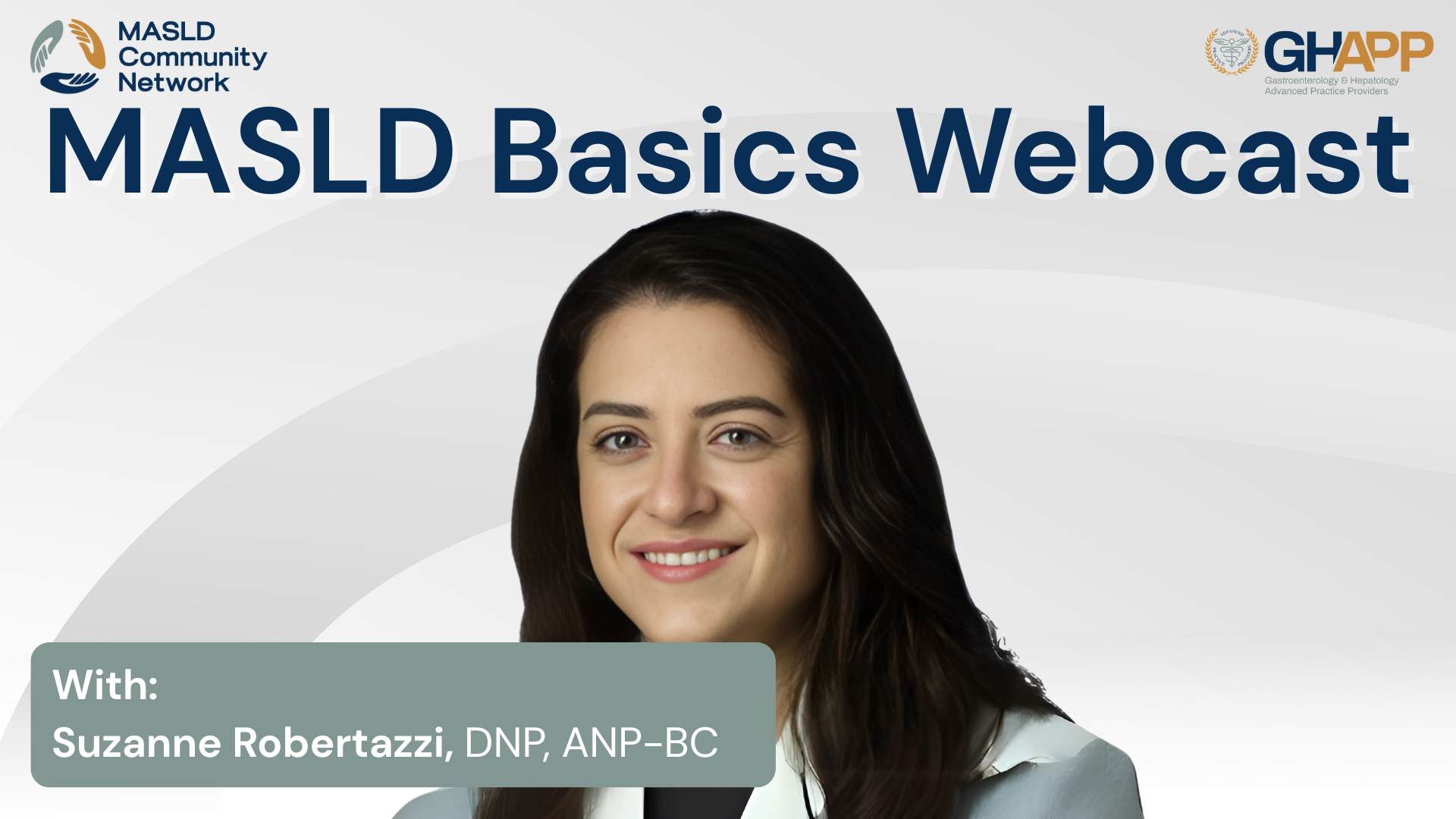
MASLD Basics With Suzanne Robertazzi

Join Suzanne, a nurse practitioner from the Washington DC VA Medical Center, as she kicks off a comprehensive lecture series on steatotic liver disease, focusing on the evolving understanding of MASLD (Metabolic dysfunction-associated steatotic liver disease) and MASH (Metabolic dysfunction-associated steatohepatitis). In this foundational session, Suzanne walks through the new nomenclature replacing NAFLD and NASH, and outlines the clinical criteria used to identify and stratify patients along the MASLD–MASH spectrum. Learn how metabolic risk factors such as obesity, prediabetes, hypertension, and dyslipidemia contribute to disease progression, and explore the use of non-invasive diagnostic tools like Fib-4, FibroScan, and ELF scores to assess fibrosis. The session also discusses indications for liver biopsy, the implications of overlapping etiologies (like alcohol-associated liver disease), and strategies for identifying patients at high risk for cirrhosis, hepatocellular carcinoma (HCC), and liver-related mortality. This lecture equips clinicians, particularly those in primary care and hepatology, with a practical framework to evaluate steatosis, interpret metabolic profiles, and determine when to refer patients for specialty care. Whether you're new to liver disease or looking for updates on MASLD and MASH terminology, this session is an essential starting point.
Watch Now

Monitoring for MASLD in Type 2 Diabetes

In this episode of the GHAPP MASLD podcast series, Lavinia Iordache, PA-C from the University of Miami, shares expert guidance on monitoring metabolic dysfunction-associated steatotic liver disease (MASLD) in patients with type 2 diabetes—a group at particularly high risk for disease progression. Lavinia explains the bidirectional relationship between MASLD and diabetes, highlighting the importance of early screening, timely non-invasive testing (NITs), and proactive management strategies to prevent advanced fibrosis and cirrhosis. She reviews essential tools such as FIB-4, ELF score, FibroScan, and MRI-PDFF, and offers clear recommendations on when to escalate care, refer to specialty clinics, or intensify follow-up. The discussion also covers the role of lifestyle interventions including the Mediterranean diet, intermittent fasting, exercise, and coffee consumption, as well as strategies to improve adherence despite psychosocial, cultural, or financial barriers. Lavinia emphasizes a multidisciplinary approach to managing MASLD and provides practical tips for tracking lifestyle changes, such as journaling and the use of the EDAS questionnaire. Whether you’re a GI, endocrinology, or primary care provider, this episode offers an actionable roadmap for reducing liver-related complications in patients with diabetes.
Watch Now
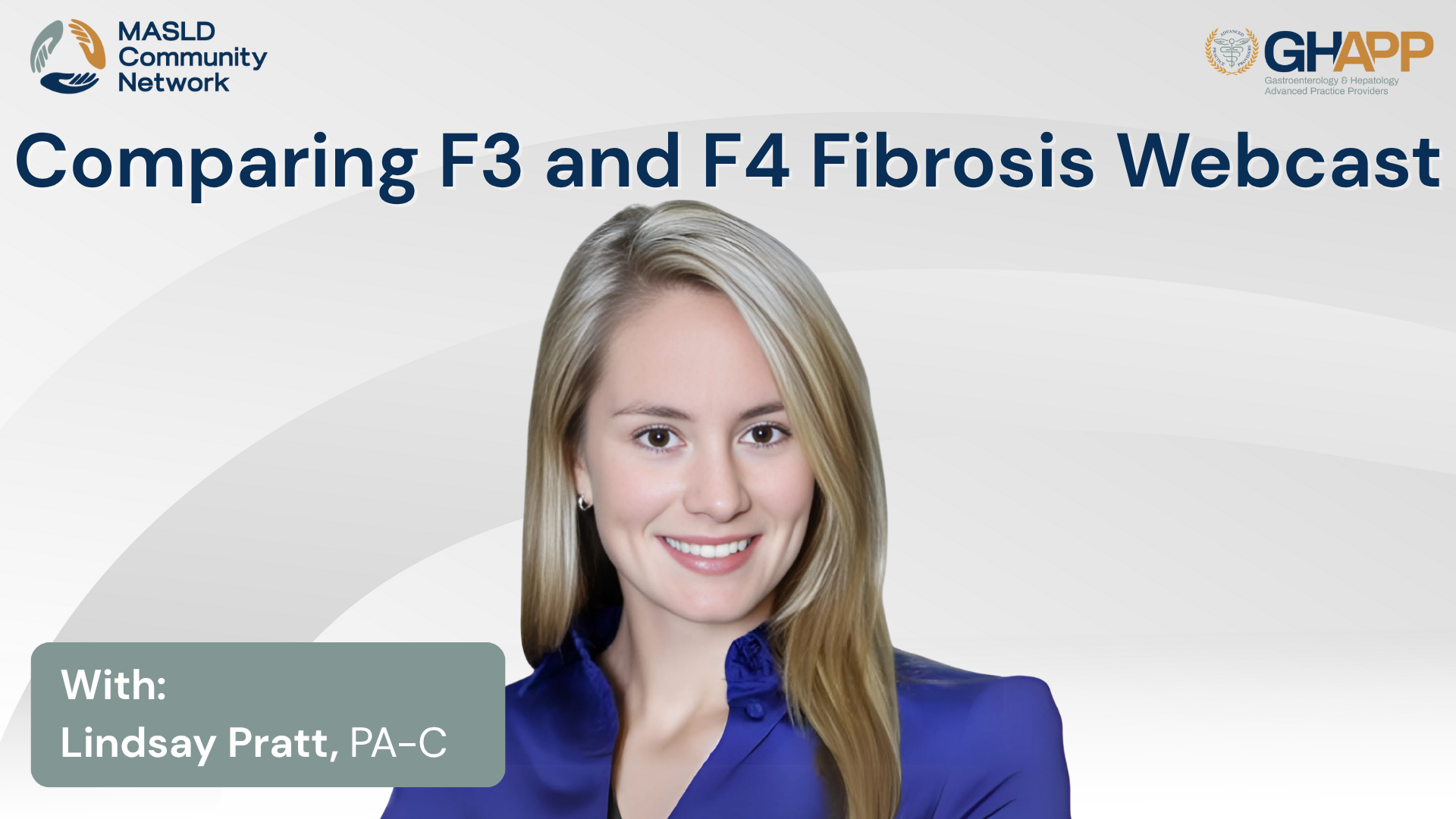
Comparing F3 and F4 Fibrosis With Lindsay Pratt

Join Lindsey Pratt, PA-C from the University of Colorado Liver Transplant Program, for an in-depth clinical comparison of F3 and F4 fibrosis in patients with MASLD (Metabolic Dysfunction–Associated Steatotic Liver Disease) and MASH (Metabolic Dysfunction–Associated Steatohepatitis). Using an identical patient profile with differing non-invasive testing results, Lindsey demonstrates how to accurately stage fibrosis using tools like FIB-4, FibroScan, CAP score, and ELF test—emphasizing when pharmacologic intervention is appropriate and when advanced monitoring becomes critical. This session explores the clinical implications of fibrosis staging, treatment pathways including resmetirom (Rezdiffra), the role of GLP-1 receptor agonists, and practical nutrition and lifestyle strategies. For F4 patients, Lindsey outlines key elements of surveillance for hepatocellular carcinoma (HCC), portal hypertension management, and transplant evaluation. Whether you're in hepatology or primary care, this case-based discussion offers evidence-backed guidance for managing patients across the MASLD/MASH spectrum and preventing liver disease progression.
Watch Now
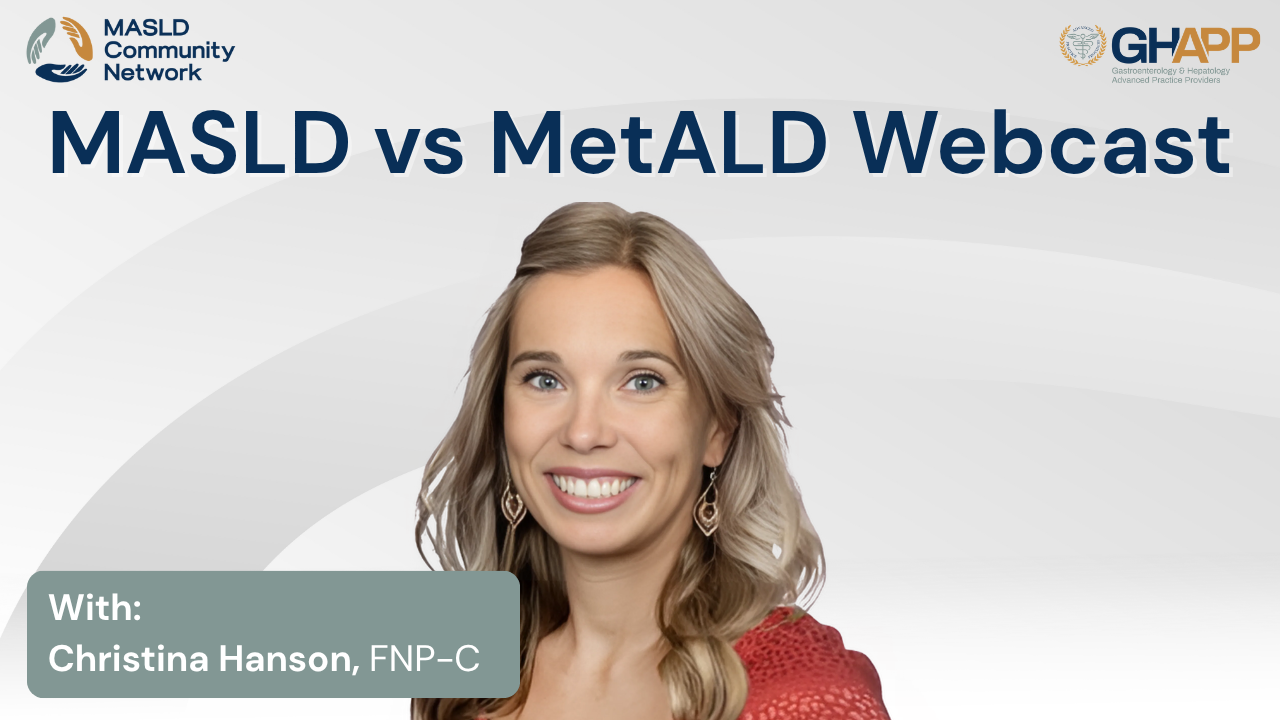
MASLD vs MetALD With Christina Hanson

Discover the latest insights on MASLD and MetALD in this educational session from the GHAPP MASLD Community Network. Christina Hanson, FNP-C, walks through a real-world case study to highlight how common metabolic conditions like hypertension, hyperlipidemia, obesity, and PCOS intersect with alcohol use to drive liver disease progression. The session explores updated nomenclature replacing NAFLD/NASH, the role of FibroScan and elastography in staging fibrosis, and the importance of screening patients with metabolic risk factors for fatty liver. Learn how alcohol consumption contributes to liver injury, triglyceride elevation, and blood pressure changes, and how objective biomarkers such as PEth testing are transforming diagnosis beyond self-reporting. Christina also reviews lifestyle interventions, dietary strategies like the Mediterranean diet, and current treatment considerations for patients with advanced fibrosis (stage 3), including when to initiate HCC screening. Whether you are a hepatologist, GI specialist, or advanced practice provider, this session provides practical tools for evaluating and managing patients with MASLD, MetALD, and related liver health challenges.
Watch Now
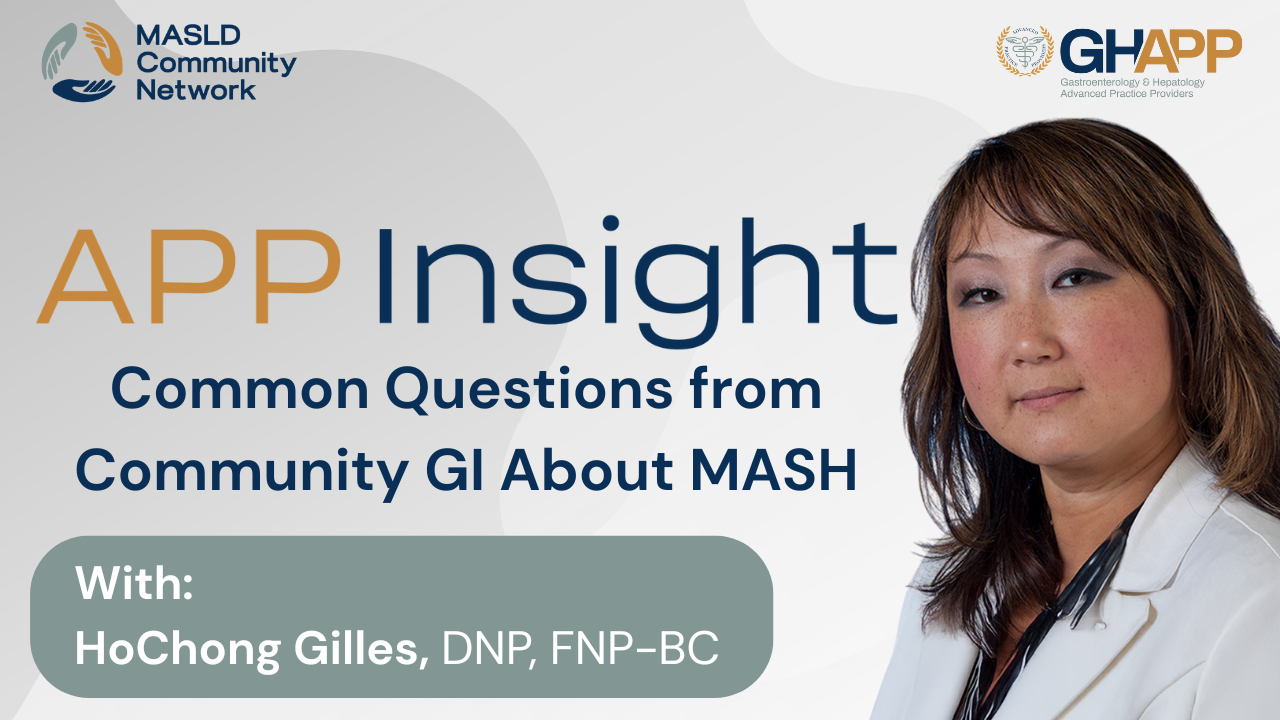
Common Questions From Community GI About MASH

In this educational video, HoChong Gilles, NP—Clinical Program Director at the Central Virginia VA Healthcare System—breaks down practical, non-invasive strategies for evaluating liver fibrosis in community GI and primary care settings. With over 25 years of hepatology experience, she walks through the importance of calculating the FIB-4 score using just four parameters: age, ALT, AST, and platelet count. Learn how to interpret FIB-4 score cutoffs to determine low, indeterminate, or high risk of advanced fibrosis and explore alternative tools like the ELF (Enhanced Liver Fibrosis) test when imaging options are limited. Whether you're a hepatology specialist or a frontline provider, this video offers actionable insights to help bridge the gap in liver care access using guideline-supported lab-based methods.
Watch Now
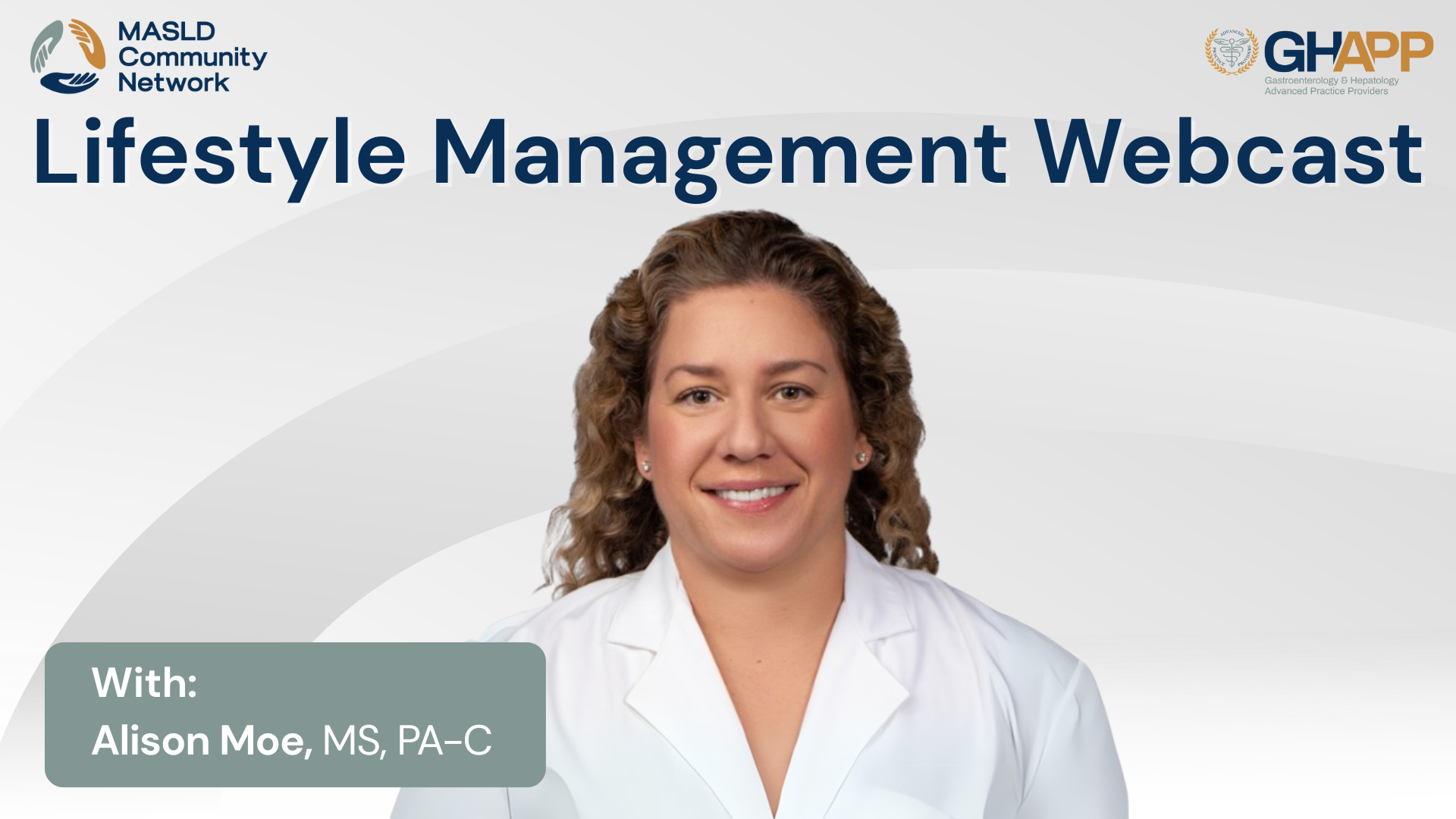
Lifestyle Management With Alison Moe

Join Alison Moe, PA-C, from Atlanta Gastroenterology Associates, as she walks through a real-world clinical case highlighting the challenges and strategies in managing Metabolic Dysfunction-Associated Steatotic Liver Disease (MASLD) and Metabolic Dysfunction-Associated Steatohepatitis (MASH). In this engaging and educational session, Alison shares the case of a 65-year-old Hispanic male with obesity, type 2 diabetes, and fatty liver disease—diving deep into non-invasive diagnostic tools, including FIB-4 scoring and FibroScan, and how these help guide risk stratification for liver fibrosis. The discussion emphasizes the crucial role of dietary counseling, culturally sensitive lifestyle modifications, and exercise guidance to slow or even reverse disease progression. Learn how to set achievable goals for patients and explore effective methods for improving glycemic control, BMI, and overall liver health. Alison also touches on evidence-based interventions such as the Mediterranean diet, resistance training, and intermittent fasting, supported by AASLD and European liver guidelines. Whether you're a clinician treating MASLD or simply interested in the evolving approach to fatty liver disease, this case study offers practical takeaways and guidance to optimize patient outcomes.
Watch Now
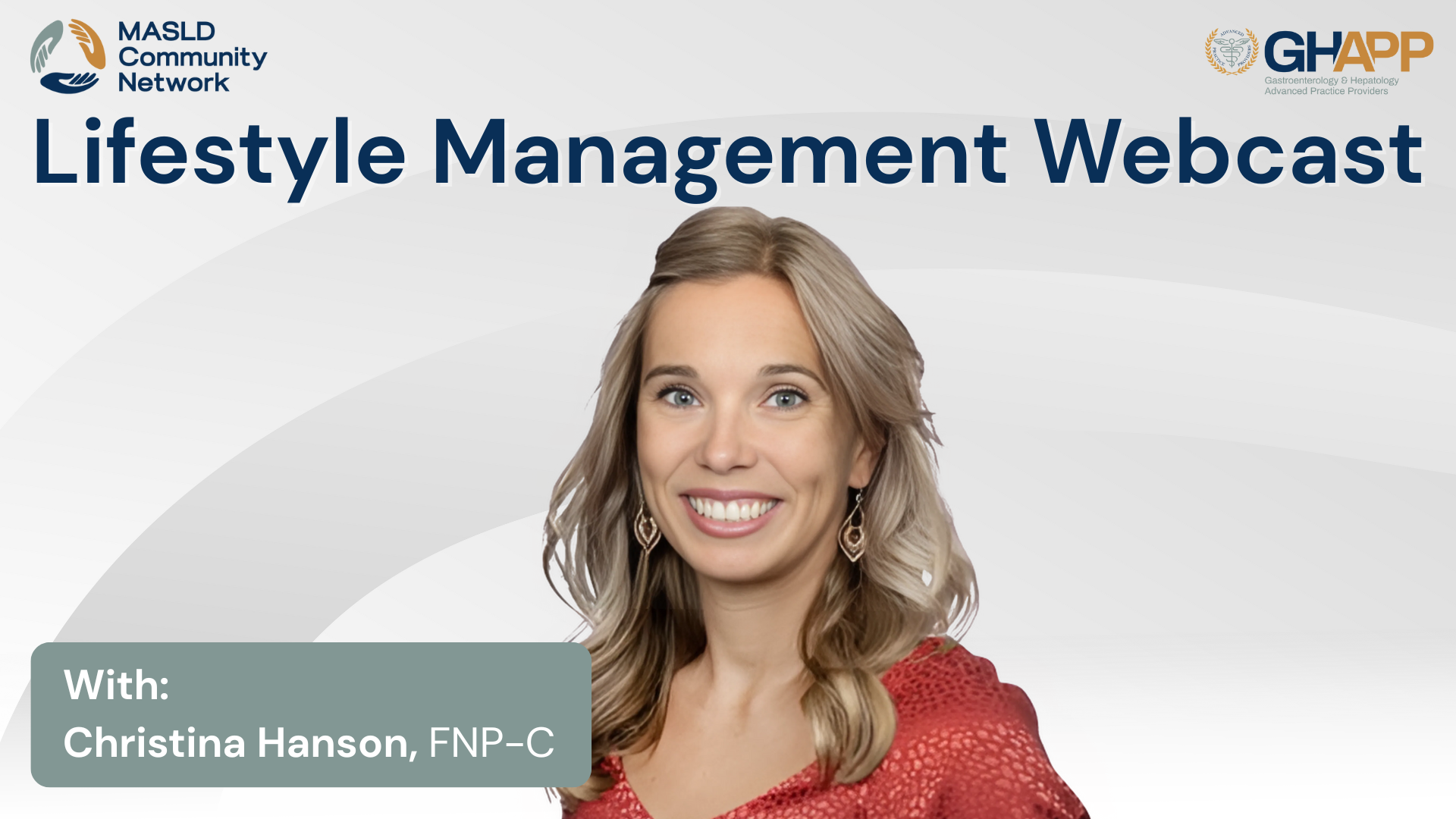
Lifestyle Management With Christina Hanson

Join Christina Hanson, NP from South Denver GI, for a practical and in-depth discussion on lifestyle management of MASLD (Metabolic Dysfunction-Associated Steatotic Liver Disease) and MASH (Metabolic Steatohepatitis). In this GHAPP MASLD/MASH Community Network session, Christina walks through the case of Albert, a 65-year-old patient with obesity, diabetes, and abnormal liver findings—representing a common clinical scenario in primary and specialty care. This session highlights how to apply non-invasive fibrosis assessment tools like FIB-4 and FibroScan, interpret metabolic risk factors, and differentiate patients based on fibrosis staging. Christina discusses how cultural dietary habits, access to care, and social determinants of health impact disease management, and emphasizes the importance of personalized counseling, accountability strategies, and gradual, sustainable changes to diet and exercise. The session also reviews the role of Resmetirom, the first FDA-approved treatment for MASH with F2-F3 fibrosis, and outlines guideline-recommended lifestyle interventions including the Mediterranean diet and combined aerobic/resistance exercise. Learn how to identify, stage, and manage patients with MASLD and MASH in a way that supports long-term adherence and improves liver-related outcomes. Educational support provided by Madrigal Pharmaceuticals.
Watch Now





 July 2025
July 2025 